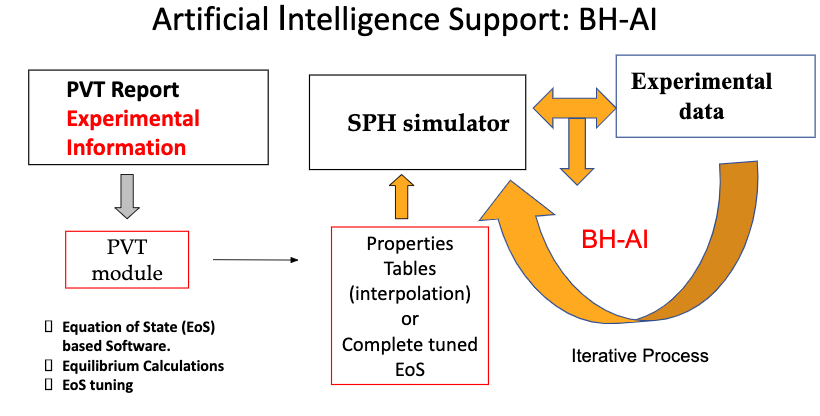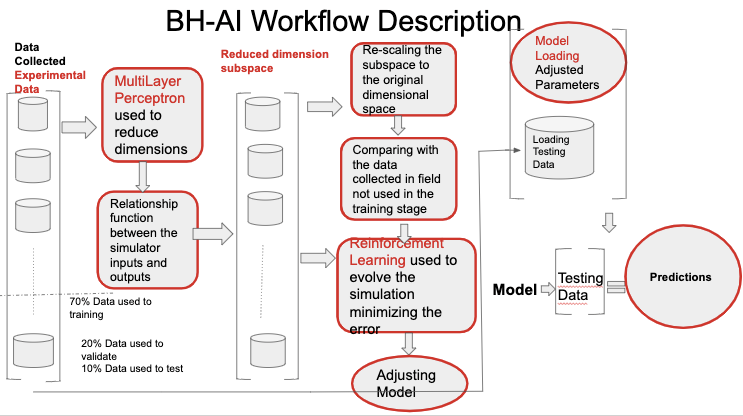ENERXICO, in the frontier of technology, is applying Artificial Intelligence (AI) techniques to automate different stages in the numerical simulators used in the oil and gas industry. Machine Learning (ML) techniques such as Deep Learning (DL) and Reinforcement Learning (RL) are being applied to help in the optimisation and tuning of the initial parameters that are needed as input data in the Black Hole (BH) oil reservoir simulator code.
Predicting fluid properties
As a first stage to automate the use of the BH numerical simulator, ENERXICO is starting with the particular case of its PVT fluid characterisation package. This package uses an Equation of State (EoS) to calculate and predict the volumetric and transport properties of reservoir fluids under different Temperature and Pressure conditions. Then, in order to provide a reasonable prediction of the fluid properties, experimental data for the particular fluid of interest must be available and the EoS parameters must be tuned to match this experimental information. Therefore, the EoS parameter tuning process is an important and complex stage due to all the different features, parameters and information that should be taken into account to fit the EoS parameters with the best possible accuracy. Usually, the experts decide about the particular approach to follow depending on the reservoir conditions and the type of fluid they are handling and make decisions like which EoS model should be chosen, e.g. Peng-Robinson and Soave-Redlich-Kwong EoS, among others, in such a way that fits the experimental data better under specific conditions.
Also, once the simulator has a tentative set of EoS tuned parameters, the model is compared with the actual experimental data, and from this comparison we know if the EoS model is accurate enough to describe the behavior of the reservoir fluid and then be capable to forecast the actual reservoir behavior. Sometimes the tuning process is not so easy or evident and may take days or even weeks for the experts to really get the best match. This complexity is due to the fact that there are several parameters (hundreds of different parameters, pure component and binary parameters) to consider when the simulation is run. Indeed, the different combinations that can be made fixing some parameters and tuning others can follow a Pareto curve. This exponential growth of combinations of the different parameters is the reason why we need the expertise of the people that have many years in the industry.
How the ENERXICO AI architecture works
In order to help in the tuning process and obtain the EoS model fitted with less time and resources, ENERXICO is developing an AI architecture called BH-AI which uses DL and RL in different steps of the pipeline. This architecture would learn from the experts, but also has an iterative process that helps to generate more data to be used in the training process. BH-AI will be able to help the experts find the best sets of parameters to tune the EoS model with great accuracy and in a smaller amount of time. That means that the BH-AI pipeline, that is in the process of being developed, is going to be able to find the best set of parameters that produce an EoS model that fits the laboratory data with great accuracy.

The architecture proposed to be used to solve this first stage is described below.
The first issue that ENERXICO wants to solve is the Dimensionality Reduction. The project needs to deal with the problem of high dimensionality since this problem arises because of the quantity of parameters that should be considered in the process of the EoS tuning. As mentioned before, the number of parameters that influence the tuning of the EoS is in the range of hundreds. Some of these parameters are physical conditions that are considered as constants in the model, but others can be tweaked in such a way that the resultant EoS model will reproduce with great accuracy the experimental data. However, some of those parameters don't have too much implication in the EoS tuning, or they are correlated with other parameters. Those parameters which show that linear dependency, can be reduced, applying some transformations and normalizations to them. The objective is to minimize the number of parameters that have the freedom to be tweaked.
There are different techniques to do this Dimensionality Reduction, and ENERXICO is experimenting with some of them. For instance, researchers are in the process of testing the neural networks called Multilayer Perceptrons (MP) which are a type of DL neural network. MP is being tested to handle the important part of the whole system which is the reduction of parameters.

The second important step in the pipeline (omitting all the steps of cleaning, normalising and storing the data, which are not less important) is the step in which the BH-AI is going to be trained to learn from the experts and from its own iterative process. In this stage, different Reinforcement Learning Techniques and RL techniques are being tested to find the better option. This pertains to the technique which has the better accuracy when matching the resultant EoS model with the experimental data.
In the RL process, ENERXICO is looking for the function (policy) which dictates an optimal action a for the current state of the system s. This will result in the “action-reaction” system description which is going to evolve with the time.
By using RL, ENERXICO can help the simulator to consider the evolution of the system under different input scenarios. Due that the simulator is already calibrated, the simulator in that moment is no longer considered by the AI system as a black box, but as an interactive system of agents interacting with the environment in discrete time steps.
After finishing with the training of the different RL techniques that are being developing at this moment, the project is going to decide which one is the best testing option in a scenario that it has not seen yet. This step is going to be crucial to decide about the accuracy of the model, and to decide if it is ready to be released as the first version of the ENERXICO BH-AI architecture.
Written by:
Jaime Klapp, Estela Mayoral and Margarita Mayoral (Instituto Nacional de Investigaciones Nucleares)
